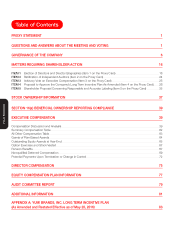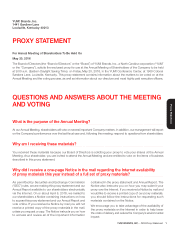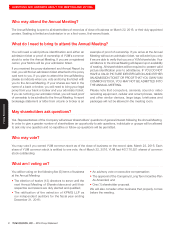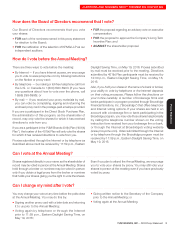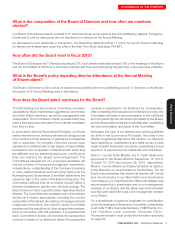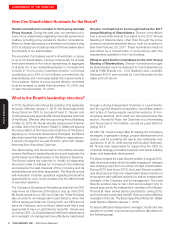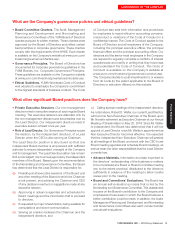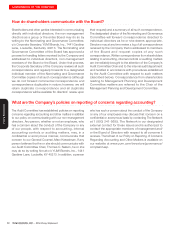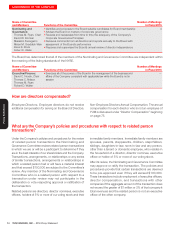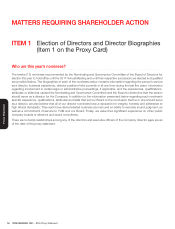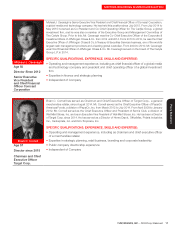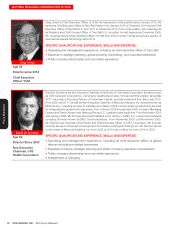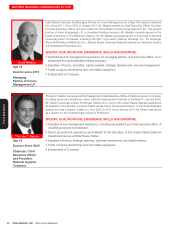Pizza Hut 2015 Annual Report Download - page 24
Download and view the complete annual report
Please find page 24 of the 2015 Pizza Hut annual report below. You can navigate through the pages in the report by either clicking on the pages listed below, or by using the keyword search tool below to find specific information within the annual report.
YUM! BRANDS, INC.-2016Proxy Statement10
Proxy Statement
GOVERNANCE OF THE COMPANY
•
Majority Voting Policy. Our Articles of Incorporation
require majority voting for the election of directors in
uncontested elections. This means that director nominees
in an uncontested election for directors must receive a
number of votes “for” his or her election in excess of the
number of votes “against.” The Company’s Governance
Principles further provide that any incumbent director
who does not receive a majority of “for” votes will promptly
tender to the Board his or her resignation from the Board.
The resignation will specify that it is effective upon the
Board’s acceptance of the resignation. The Board will,
through a process managed by the Nominating and
Governance Committee and excluding the nominee in
question, accept or reject the resignation within 90 days
after the Board receives the resignation. If the Board
rejects the resignation, the reason for the Board’s decision
will be publicly disclosed.
What access do the Board and Board committees have to management
andtooutside advisors?
•
Access to Management and Employees. Directors
have full and unrestricted access to the management and
employees of the Company. Additionally, key members
of management attend Board meetings to present
information about the results, plans and operations of the
business within their areas of responsibility.
•
Access to Outside Advisors. The Board and its
committees may retain counsel or consultants without
obtaining the approval of any officer of the Company in
advance or otherwise. The Audit Committee has the sole
authority to retain and terminate the independent auditor.
The Nominating and Governance Committee has the sole
authority to retain search firms to be used to identify
director candidates. The Management Planning and
Development Committee has the sole authority to retain
compensation consultants for advice on executive
compensation matters.
What is the Board’s role in risk oversight?
The Board maintains overall responsibility for overseeing
the Company’s risk management, including succession
planning. In furtherance of its responsibility, the Board has
delegated specific risk-related responsibilities to the Audit
Committee and to the Management Planning and
Development Committee. The Audit Committee engages
in substantive discussions of risk management at its regular
committee meetings held during the year. At these meetings,
it receives functional risk review reports covering significant
areas of risk from senior managers responsible for these
functional areas, as well as receiving reports from the
Company’s Chief Auditor and the General Counsel. Our
Chief Auditor reports directly to the Chairman of the Audit
Committee and our Chief Financial Officer. The Audit
Committee also receives reports at each meeting regarding
legal and regulatory risks from management and meets in
separate executive sessions with our independent auditors
and our Chief Auditor. The Audit Committee provides a
summary to the full Board at each regular Board meeting
of the risk area reviewed together with any other risk related
subjects discussed at the Audit Committee meeting. In
addition, our Management Planning and Development
Committee considers the risks that may be implicated by
our compensation programs through a risk assessment
conducted by management and reports its conclusions to
the full Board.
Has the Company conducted a risk assessment of its compensation policies
andpractices?
As stated in the Compensation Discussion and Analysis at
page 39, the philosophy of our compensation programs is
to reward performance by designing pay programs that
incorporate team and individual performance, customer
satisfaction and shareholder return; emphasize long-term
incentives; drive ownership mentality; and require executives
to personally invest in Company stock.
In early 2016, the Management Planning and Development
Committee (the “Committee”) oversaw the risk assessment
of our compensation programs for all employees to determine
whether they encourage unreasonable or excessive risk
taking. In conducting this review, each of our compensation
practices and programs was reviewed against the key risks
facing the Company in the conduct of its business. Based


